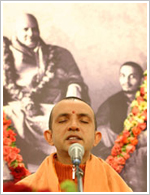Home > Steps to Meditation - Swami Niranjanananda
Steps to Meditation - Swami Niranjanananda
Swami Niranajan talks about the step by step approach to meditation practices.
Steps to Meditation
 First
component of Meditation : Relaxation
First
component of Meditation : Relaxation
The human mind indicates how sensitive and how receptive the human mind is but this
human mind is not always creatively functional because we lack awareness and the
ability of observation. The second component of meditation is this. After relaxation
you develop the ability to observe yourself. You develop awareness- expand it, nurture
it and evolve it. Thus preparing the ground for the higher practices of concentration,
visualization and meditation. The faculty and process of developing awareness comes
with the practice of antar mouna. This is also a technique of Pratyahara, the beginning
stage of mental discipline.
Second component of Meditation : Antar Mouna (Inner Silence)
What is the practice of Antar Mouna?
Becoming aware and recognizing the information that the senses are receiving. What
information are you receiving through the eyes, ears, by touch, taste, smell, by
the senses as a whole. To practice antar mouna is to develop a uniform vision of
these sensorial experiences and then take another step and begin to observe the
thoughts. Objectively begin to observe your thoughts. antar mouna means inner silence
and it is in this practice that we are able to eventually become aware of the mental
expressions in the form of thoughts, ideas, desires and expectations and learn how
to manage them. We learn how to modify them according to our needs and this is the
second practice of meditation. This practice of antar mouna stops the mental chatter.
Third component of Meditation : Focusing the Mind
Ajapa Jap (Inner Silence)
The third stage is learning how to focus the mind. For this there is another practice-
Ajapa Jap. Ajapa Jap is a practice in which we combine breath awareness with mantras,
using breaths. Mantras help us to focus, fix and isolate the mind from distractions.
In this manner gradually we go through the process of mental training and mental
education. This is known as the meditational process of yoga. The journey that begins
from Pratyahara and ends in Dharna; because after that Dhyana is a state.
So far we have seen the basic preparation of meditation and how to prepare our mind
for it. But beyond this, when we discuss the philosophy of the meditation we perceive
the goal of meditation. When you begin the process of meditation three things are
initially involved. First the practitioner, second is the aim of meditation which
he wants to achieve and third is the process of meditation by which he wants to
achieve his goal.
The initial stages of meditation start with studying traywad. Traywad means three
specific inspirations. The first inspiration is our self, the second inspiration
is the aim of meditation which we need to achieve and third inspiration is the process
of meditation which we are is following.
As we are progressing in this way, the process of meditation get drops down because
it becomes natural. Then meditation enters into Dwayat from Trayat. At this stage
there is presence of the student himself and his aim. The same process keeps on
progressing. At the end Dwayat ?I? fades away and only the aim remains which we
achieve.
The progression of meditation starts ends with Adwait (non - duality). This is the
philosophy of meditation, the principle of meditation and the way to concentrate
the mind.
By Paramhansa Swami Niranjanananda
Saraswati
www.yogavision.net
![]()

